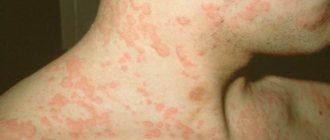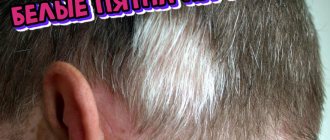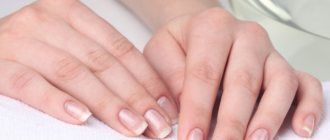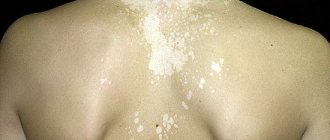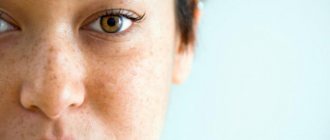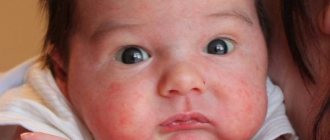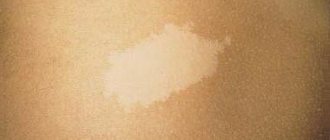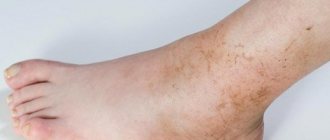Brown spots on the legs are a sign of pathological processes occurring in the layers of the dermis and in other systems of the body. The appearance of areas of pigment on the leg, foot, fingers or nails is only in rare cases the result of excessive tanning or diligent hair removal or depilation; in others, they require a visit to a doctor and a detailed examination.
“Coffee” pigment spots
This type of skin pigmentation is common in newborns.
The color of the new growths can range from light beige to dark brown. Such age spots appear in children on any part of the body, but are more common on the face, arms, legs and back. “Coffee” neoplasms can appear during the first two weeks of a baby’s life, and then disappear on their own without a trace after a few months. There is no need to treat such spots - they do not cause any disturbances in the healthy functioning of the baby’s body.
A hemangioma is a pink or red spot on the skin. Its difference from other types of age spots is that it is not an accumulation of melanin, but a benign tumor that forms as a result of damage to blood vessels. According to medical statistics, such age spots are common in children in the first six months. In addition, it is noted that such neoplasms are more common among girls.
The reasons for the development of such a tumor are intrauterine disorders in the formation of the fetal circulatory system, as well as complications during childbirth. In 70% of cases, the neoplasm disappears on its own by the age of 7. Of the remaining 30%, 10% of children experience involution of hemangioma during adolescence. This happens due to changes in hormonal levels.
This type of pigment spots can form not only on the skin, but also on internal organs, disrupting their functioning. Therefore, hemangioma can be dangerous to the health and life of the child. If pink or red pigment spots appear on a child’s arm, face, occipital region, or abdomen, then there is a need for a full medical examination of the little patient and further specialized monitoring of neoplasms.
Insect bite stains
With the onset of the warm season, red spots can be seen on the bodies of babies. They are formed from insect bites, such as mosquitoes, wasps and bees (you definitely won’t miss this), midges, fleas.
But what if the spots occur in winter? At this time of year, mosquitoes and others listed above clearly do not move around. Then thoughts may come to mind about bedbugs, lice or linen mites.
- The spots have a red tint. In some places they may swell and resemble tubercles in shape. This swelling occurs due to the penetration of insect poisons under the child’s skin.
- As a rule, these spots do not require special treatment. It is enough to eliminate the source of the bites and the skin of the young body is regenerated again
- In case of allergies, antihistamines such as Suprastin, Tavegil, Fenistil drops and ointments, and others are used. In case of severe allergic reactions (Quincke's edema, fainting), it is necessary to be under the supervision of a doctor.
“Mongoloid spot”
This type of pigmentation is a type of nevus. Externally, it is a large pigmented spot in a child, similar to a hematoma, which is most often found on the buttocks, lower back or leg. In 90% of cases it occurs in children of the Mongoloid race. In our country, babies from mixed marriages are most often born with this skin defect.
Such a pigment spot does not pose any danger to the baby’s health and in most cases disappears or significantly brightens on its own by the age of 5.
Freckles
Freckles, or “sun-kissed” freckles, appear in children over one year of age if there is a genetic predisposition. They are one tone darker than the base color of the skin. In addition, in the summer, under the influence of sunlight, the spots become brighter, but in the winter, on the contrary, they fade. Orange-brown “hemp” covers the cheeks, forehead, and chin. Freckles are also found on the shoulders, back, and legs.
Such pigmented skin was previously considered a characteristic feature of lower-class people. Today, freckles are a reflection of the individuality of their owner. In addition, it is noted that such spots gradually fade starting from the age of 25.
Nevertheless, quite often owners of “sun spots” turn to specialists to remove such pigmentation. There are a variety of methods for eliminating freckles:
- cosmetic whitening products and folk recipes;
- cryotherapy;
- chemical peeling;
- laser therapy;
- dermabrasion;
- removal by light waves.
But before deciding to use the above methods, it is worth considering that removing age spots always leads to trauma to the skin, and irreversible complications often occur.
Thus, any neoplasms on a child’s skin require examination and observation. If in some cases pigment spots in children turn out to be absolutely harmless, then in others they are dangerous for the baby. Therefore, timely detection of the problem and provision of necessary medical care can preserve the health of the baby.
Freckles are small spots of light brown color, most often localized in the face area. This pathology is more common in children. Symptoms of the pathology are more pronounced in the summer months. Most often, the appearance of freckles is influenced by a hereditary factor.
Urticaria pigment type
Urticaria pigmentosa is a rather complex disease that can act as the main cause of mastocytosis. This form of pathology most often manifests itself in children of a younger age group and is characterized by the appearance of small dark red spots.
The appearance of spots is considered only the initial stage of the development of the disease. Next, rash bubbles filled with subcutaneous fluid appear at the site of the spots. At the final stage of development, the rash opens and leaves brown spots in its place. Such spots disappear on their own within a few months.
Having manifested itself in childhood, the disease is quite mild. However, at a more mature age, various complications may develop. Experts say that urticaria pigmentosa can cause disability and even death. More often, such situations are observed against the background of a long-term lack of attention to the disease.
Mastocytosis of this form has an unclear etiology. Experts attribute this pathology to the influence of the following factors:
- sudden climate change;
- inflammatory processes against the background of the activity of various infections;
- prolonged exposure to ultraviolet radiation;
- stress;
- disorders associated with the functioning of the immune system.
Lentigo
Lentigo is a benign disease that causes brown spots on the skin. This type of neoplasm has an appearance similar to moles. If dark spots of this type appear on the skin, they can be localized in the face, legs, limbs and upper torso.
This disease has a slow progression and can appear at any age. The risk of spots degenerating into a malignant tumor is minimal. However, if the integrity of the skin is compromised, increased attention should be paid to the state of your health.
The main reason for this problem is long-term exposure to artificial radiation sources. In addition, lentigo spots can be associated with gene mutations, the activity of papillomavirus and various disorders of the immune system.
Experts especially highlight the influence of hormonal disorders and the effects of ultraviolet rays on the formation of such spots. In addition, lentigo spots can be caused by AIDS and other diseases leading to a severe decrease in immunity.
Problems with hyperpigmentation in this disease appear in the form of single spots of uniform color with clearly defined boundaries. Neoplasms can be localized in various parts of the body, including the face and limbs. Lentigo spots most often appear at one of the stages of child development in the womb. However, in medical practice, cases are described when this pathology manifests itself at a more mature age.
Pigments are responsible for the color of human skin; in healthy skin there are five of them: melanin, carotene, melanoid, oxyhemoglobin and reduced hemoglobin.
What is it and what causes it?
When is a spot on an arm or knee just a freckle or birthmark, and when is it a symptom of a disease? Why does the skin become covered with such unpleasant spots and how to get rid of this pathology? Excessive pigmentation on the legs is the result of the accumulation of melanin pigment in the upper layers of the dermis. Relatively harmless reasons for the appearance of areas of hyperpigmentation are excessive exposure to the sun and solarium, allergies to creams or other cosmetics.
Sometimes such spots develop after an insect bite or as a result of local damage to the capillaries - a kind of bruises. They are round in shape. In these cases, the size of the pigmentation area is small and does not require treatment.
Causes of pigmentation on the legs:
- Violation of the trophism of skin vessels - the presumed diagnosis may be varicose veins, diabetes mellitus, atherosclerosis.
- Neurofibramatosis - multiple pigment spots on the skin of a milky brown color. This is a hereditary disease.
- Pigment spots that appear on the legs are one of the symptoms of chronic dermatitis. The disease is recurrent. May be caused by external factors: wearing tight shoes or tights, allergies to clothing fabric, cream. The congestive form of dermatitis is characteristic of varicose veins of the deep veins of the extremities. In this case, they may itch, peel, become rough, be rough and convex to the touch.
- Diseases of the gastrointestinal tract - dark skin color is a sign of hepatitis of any origin, fibrosis or cirrhotic changes in the liver.
- Carcinomas of various organs, including skin. Dangerous spots are those that have a high expansion rate and are located on the sole. This area is difficult to explore on your own. Such areas of the dermis are dry and compactions appear on them.
Dubreuil melanosis
This disease is oncological in nature. The appearance of small spots that are dark in color and irregular in shape often indicates the development of skin cancer. This form of neoplasm is most often localized in the upper body. Brown growths at the initial stage of development are very similar to moles and rise slightly above the surface of the skin.
At the initial stage of development, the spots have a small diameter, but over a short period of time their diameter increases several times. The color of the new growths can vary from light yellow to dark brown. The outline of the growths can be compared to a geographical map. The development of the disease leads to the formation of nodules and papules on the surface of the affected tissues and tumors themselves. The stain changes its structure, becoming denser.
The disease is accompanied by severe itching and redness of those areas of the skin that are nearby. The brown spot on the skin begins to peel off towards the end of the development stage. At the same stage, small spots similar to freckles begin to form on healthy areas of the skin. The appearance of these symptoms indicates the beginning of the degeneration of the spot into a malignant tumor.
Lightening stains at home
You can remove brown spots on the lower legs using traditional medicine. There are many effective recipes that effectively help fight severe pigmentation.
- Grate fresh cucumber and apply to the shin daily for 20-30 minutes.
- Grind 50 g of cottage cheese with yolk and 5 drops of hydrogen peroxide. Apply as a mask to the shin area and hold for 15-20 minutes.
- Lemon with water in a 1:2 ratio works great for pigmentation. This product is used as a lotion, which is used to wipe the area of the face, hands and lower extremities.
- Parsley has long been used to treat pigmentation. Can be used pure or mixed with milk in equal quantities. The mixture is applied to the feet and washed off after 30 minutes. You can also treat synovitis of the ankle joint at home.
Remember, folk remedies only lighten the skin, but do not eliminate excess pigmentation, which means it will constantly remind you of itself. To solve the problem permanently, you should consult a dermatologist.
Ivanova Svetlana
General practitioner of the second category, transfusiologist, 29 years of experience
Diagnosis and treatment of problems with the musculoskeletal system (lower leg) and abdomen.
- pain and discomfort in the abdomen;
- bruises and injuries of the lower leg;
- cough, chest pain;
- acute respiratory infections, ARVI;
- food poisoning;
- cold;
- runny nose;
- general malaise;
- headache;
- aching joints;
- elevated temperature.
- Diploma in the specialty “General Medicine (Treatment and Prevention)”, Chuvash State University named after. I.N. Ulyanova, Faculty of Medicine (1990)
- Internship in the specialty “Selected Issues of Therapy”, Kazan State Medical Academy (1996)
Refresher courses
- “Nephrology issues for therapists”, State Institute for Advanced Training of Physicians named after V.I. Lenin (1995)
- “Therapy”, Kazan State Medical Academy (2001)
- “Transfusiology”, Russian Medical Academy of Postgraduate Education of the Ministry of Health of the Russian Federation (2003)
- “Therapy and Pulmonology”, St. Petersburg Medical Academy of Postgraduate Education of the Federal Agency for Health and Social Development (2006)
- “Transfusiology”, St. Petersburg Medical Academy of Postgraduate Education of the Federal Agency for Health and Social Development (2007)
- “Transfusiology”, Institute for Advanced Medical Studies of the Ministry of Health and Social Development of Chuvashia (2012)
- “Therapy”, Institute for Advanced Medical Studies of the Ministry of Health and Social Development of Chuvashia (2013)
- “Therapy”, Peoples' Friendship University of Russia (2017)
Place of work: MedCenterService clinic on Kurskaya
Brown spots on the legs are a sign of pathological processes occurring in the layers of the dermis and in other systems of the body. The appearance of areas of pigment on the leg, foot, fingers or nails is only in rare cases the result of excessive tanning or diligent hair removal or depilation; in others, they require a visit to a doctor and a detailed examination.
Toxic type melanosis
This form of pathology is observed in people who are constantly exposed to various aggressive chemicals due to their profession. Prolonged contact with fuels and lubricants (oil, coal, oils) is one of the most common causes of pathology.
Prolonged contact with this category of products leads to acute toxic poisoning. Lack of attention to this problem can cause not only spots on the body, but also a chronic form of the disease. Against this background, various pathological processes are observed in the work of many body systems and a severe deterioration in health.
Complications
The richer the color and larger the size of the spots on the legs, the worse it is. Severe complications are likely:
- thrombosis;
- rupture of the vessel and extensive bleeding;
- thrombus rupture, pulmonary embolism.
Cyanosis of the extremities indicates poor circulation. This condition is very dangerous as it can lead to tissue necrosis and gangrene.
In general, poor circulation due to vascular diseases leads to rapid fatigue, pain in the legs, and a feeling of heaviness. Because of this, productivity decreases.
Is nevus dangerous?
This type of mole looks like a small spot colored yellow-brown. Such neoplasms most often have uneven borders. Becker's nevus in most cases occurs in adolescents between the ages of ten and fifteen years. According to statistics, this disease is more common among males.
Becker's nevus is most often localized in the lower extremities and upper torso. At the initial stages of formation, the spots have a small diameter, but the development of the disease leads to a significant increase in their size. The average diameter of neoplasms can exceed ten centimeters.
Becker's nevus is a disease of unknown etiology. Experts associate the appearance of this disease with hormonal disorders.
Pigment spots, especially multiple ones, are a cosmetic defect
A nevus is nothing more than a mole. But, as is known, such spots under certain conditions can transform into a malignant tumor. Therefore, such skin defects require medical supervision. If the color or size of the spot changes, nodules form on it, or there are a large number of moles, the neoplasms should be examined as soon as possible to determine their benignity.
The cause of the appearance of nevi may be a genetic predisposition or endocrine diseases. Depending on the causes of formation and the nature of pigmentation, the doctor may recommend conservative or surgical treatment.
Pathologies that provoke the appearance of spots on the legs
There are a lot of diseases that cause spotting of the lower extremities. These are skin and systemic diseases, infections, disruptions in the endocrine and reproductive systems. Also, a similar phenomenon is caused by disturbances in the functioning of the liver, gall bladder, and kidneys. But there are pathologies for which the appearance of spots is a mandatory symptom and one of the main manifestations.
- Phlebeurysm. A very common disease. It is diagnosed in approximately half of the world's population. It occurs due to incompetent valves in the vessels and impaired blood flow. The main reason for weak vein tone is genetics. But in order for varicose veins to develop, predisposing factors are needed. These include a sedentary lifestyle, heavy physical activity, excess weight and wearing high-heeled shoes. The disease begins with swelling, heaviness in the legs, and slight pain. Then spider veins appear. After some time, the veins begin to swell and dark, hard spots appear on the legs. As the disease progresses, the pigmentation becomes black. In some places, the skin turns white and sinks, weeping, inflamed areas and trophic ulcers appear. At the initial stage, external agents are used. Severely damaged veins are treated with special injections or laser. For prevention, it is important to walk more, do gymnastics and wear high heels as little as possible.
- Eczema. A dermatological disease caused by allergies, metabolic disorders, malfunctions of the nervous or endocrine system. Often becomes chronic with periodic relapses. It usually presents as a rash in the form of watery blisters, redness and peeling of the skin, itching and swelling. A type of disease that is localized in the lower extremities is varicose eczema. Occurs due to poor circulation and blood stagnation. The skin on the legs darkens unevenly, red spots and irritation appear, and ulcers do not heal. Manifestations are usually concentrated in the lower part of the leg. For treatment, corticosteroids, sedatives and antihistamines are prescribed. For local treatment, lotions, ointments and gels are used. If an infection occurs, antibiotics are indicated. Varicose veins require mandatory treatment of dilated veins.
- Purpura. Minor hemorrhages in the skin due to the release of red blood cells from the vessels. It is a symptom, not an independent disease. This phenomenon is typical for impaired platelet production, blood stagnation, coagulation problems, intoxication, and pathology of the vascular wall. The rashes appear as dark spots on the legs, like bruises. At first they are red or burgundy, then gradually darken to purple, and when they resolve, they acquire a yellow tint. At the same time, convulsions, fever, headaches and abdominal pain, and arrhythmia may occur. Therapy is reduced to reducing the production of antiplatelet bodies. Patients are prescribed hemostatic agents and aminocaproic acid. If there is a risk of bleeding into the brain, platelet infusions are given. In severe cases, excision of the spleen is indicated.
- Lichen. Fungal skin infection. Usually characterized by pink or red rashes, but with pityriasis versicolor, brown spots appear. Most often they are concentrated in the upper torso, but sometimes they spread to the legs. Pigmentation changes shades to yellow and pink, the affected areas merge with each other, forming extensive lesions. At the same time, the skin peels and itches. Often the chronic course of tinea versicolor with relapses in spring and summer. For treatment, local antifungal agents are used. In severe cases, antimycotic drugs are prescribed for oral administration.
If a dark spot appears on your leg, you cannot ignore it. Periodically occurring defects indicate malfunctions in the body. Unusual pigmentation can signal a problem in any organ. Therefore, when it appears, you should visit a dermatologist. He will identify skin diseases or refer you to other specialists. If it turns out that there are no serious pathologies, then you can cope with the problem with the help of bleaching agents and cosmetic procedures.
Pathology named after Recklinghausen
This disease is better known as neurofibromatosis type 1. At the initial stage of development, small spots form on the patient’s body, on which a cluster of freckles forms. Most often, the disease manifests itself in childhood. New growths can vary in color and size.
In approximately fifteen percent of cases associated with the presence of pathology, the development of the disease leads to oncological complications. In addition, experts talk about an increased risk of developing the following pathologies:
- cyst in the respiratory organs;
- slow growth and the appearance of empty cavities in the spinal cord;
- gynecomastia and renal artery stenosis.
As a result of the accumulation of melanin in large quantities on the skin, age spots are formed.
Problems appearing on the toenails
Brown spots on the toenails are caused by wearing uncomfortable shoes. The nails are injured, blood circulation is disrupted, which leads to a change in the color of the nail part.
Find the answer
Are you having any problem? Enter “Symptom” or “Name of the disease” into the form, press Enter and you will find out all the treatment for this problem or disease.
But there will be other causes of dark spots:
- Bruising, which subsequently appears as dark spots;
- Vitamin deficiency, lack of vitamin B 12;
- Kidney failure;
- Heart diseases;
- Bronchitis or lung problems;
- Malignant melanoma;
- Longitudinal, brown stripes on the nail plate indicate pigmentary pathologies;
- If the spot appears on the large nail, around the skin, this may indicate manifestations of psoriasis.
Brownish spots on the nails do not always mean the presence of a disease. Changing the color of the nail plate is associated with improper care of this part of the body.
Acquired factors
Has your child developed pigment spots? The reasons for this condition may be diseases of the internal organs or the negative impact of external factors. In particular, the appearance of skin tumors can be provoked by the following factors:
- diseases of the gastrointestinal tract;
- injury;
- changes in hormonal levels;
- metabolic disease;
- sudden change in climate and diet;
- taking certain medications.
Prevention of occurrence
Prevention of hyperpigmentation is not a specific drug therapy, but a lifestyle.
- take vitamins;
- do not expose the skin to excessive ultraviolet irradiation;
- use protective creams;
- if you have to walk, apply sunscreen to areas of pigmentation;
- drink enough liquid.
Removing brown spots using cosmetics is not a solution. It is not difficult to remove an aesthetic defect. But, if a pathological process is hidden under the change in skin color, then it is impossible to get rid of brown spots without proper treatment.
As a rule, most forums, discussions and recommendations on the Internet that relate to problems with skin pigment metabolism are intended for women. Meanwhile, a significant number of men may also experience similar problems, they just do not concern the stronger sex as much. But such an indifferent approach is not entirely correct, since skin pigmentation disorders (for example, age spots on the legs) may indicate a serious condition of the body. And after a short period of time, we may not be talking about eliminating a cosmetic defect, but about the full treatment of diseases of internal organs.
Reasons for education
Have your child noticed pigment spots? The reasons for their appearance may be different. In the medical literature, two large groups of factors are distinguished that can provoke the formation of pigmentation on the skin:
- congenital;
- acquired.
So, the first category includes genetic predisposition. If immediate relatives are susceptible to the formation of pigment spots, then there is a high probability of their occurrence in the child.
Congenital factors also include skin tumors that appear as a result of complications that arise during labor.
Drug treatment
It will be possible to remove age spots on the legs of men and women only by identifying and eliminating the causes of their appearance. If the cause is pathological processes, you should first treat them, and the spots will go away on their own over time.
To get rid of pigmentation, the patient is advised not to scratch his legs, wear comfortable shoes and clothes, not use cosmetics if he has allergies, and treat diseases in a timely manner.
Topical preparations will help lighten the skin:
- Achromin - reduces the synthesis of melanin, due to which its accumulation decreases and spots become lighter. Available in the form of a 45 ml cream. Do not use during pregnancy, children under 12 years of age, while breastfeeding or in case of hypersensitivity. The product must be used at least 2 hours before going out into fresh air. If this rule is not followed, new areas of pigmentation may appear on the skin.
- Atralin is an effective ointment that helps reduce the amount of melanin in the skin. It must be used under the strict supervision of a doctor, following all recommendations. The ointment is contraindicated for pregnant women, lactating women and people with intolerance to the components of the product.
Causes of the disease
Diseases of high severity are quite common today. Chronic forms of these diseases often lead to disorders associated with melanin synthesis. The list of these diseases includes the following pathologies:
- Liver dysfunction due to cirrhosis and other diseases of this organ. It is this type of disease that most often leads to the appearance of small areas on the surface of the skin, colored in dark tones.
- Disturbances in the functioning of the endocrine system. Disruptions of the endocrine system have a huge impact on the quality of the metabolic system. Hormonal disorders, pathological processes in the functioning of the sweat glands, diabetes mellitus are only a small part of the reasons leading to the appearance of spots of non-standard color.
- The cachectic form of melanosis quite often accompanies a disease such as tuberculosis.
- Kidney dysfunction can also be expressed by the appearance of areas with an unnatural color. This form of the disease is called uremic type melanosis.
The above reasons are the main factors leading to the appearance of melanosis. However, this disease may also have a different nature, not associated with disturbances in the functioning of internal organs.
Reasons for male and female character
The female half of the population may experience pigmentation of the lower extremities due to hormonal disorders. But this problem usually goes away on its own when the changed background is restored again. A more serious disease is chloasma. This pathological process is also associated with hormones and disruptions in the endocrine system.
In men, the appearance of dark spots on the lower extremities is caused by a disease such as Becker melanosis. The lesions are characterized by irregular shape and uneven edges, and increased hair growth is observed near such an area. In addition, men are susceptible to a disease such as Schamberg's disease. In this case, red heels first appear on the lower extremities, which subsequently turn into dark brown bruises.
Leopard cider
Leopard syndrome is a rare disease that manifests itself in the form of many spots on the body of various colors. Such pathology can be localized in various parts of the body.
In addition to the appearance of spots, patients experience problems with the functioning of the heart muscle, slight mental disabilities, hypospadias, disturbances in the functioning of the respiratory organs and growth retardation. The formation of this disease is associated with the mutation of certain genes.
How to get rid of pigmentation on different parts of the legs
You can get rid of the hated age spots on your legs when the cause of the pathological process is determined.
If areas with suspicious pigmentation appear, you should contact a dermatologist, endocrinologist, phlebologist, gastroenterologist, or for women, a gynecologist and undergo a comprehensive examination. If a dermatologist suspects a malignant nature of the formation, he will refer you for a consultation with an oncologist.
Treatment goals for extremity hyperpigmentation:
- therapy of the underlying disease;
- strengthening the immune status of the body;
- use of antihistamine ointments, drugs;
- When venous strands appear in varicose veins, sclerotherapy is a gentle treatment method. A special drug is injected into the affected area, which glues the walls of the vessel. The technique allows you to remove a section of the vein without surgical intervention.
If such spots appear in a child, and especially in an infant, you should immediately contact a medical facility.
Telangiectasia or “stork bite”
Every third newborn is born with pink spots on the back of the head, temples, forehead or cheeks. Popularly, such pigmentation is called “stork bite,” but in medicine it is designated by the complex term “telangiectasia.”
The cause of these spots is the intrauterine pressure of the mother's pelvic bones on the baby. This happens at the end of the third trimester, when the fetus takes a head-down position in the uterus. In addition, during passage through the birth canal, trauma to the skin is also possible, which leads to the formation of such pigmentation in the newborn.
Telangiectasias may gradually become paler, but in some cases remain for life. Such age spots in children do not pose a health hazard and cannot be treated.
Why do spots appear on my legs?
https://www.youtube.com/watch?v=TNQHYps8Rl4
Brown spots appear on the legs for many reasons. Non-hazardous factors include: consequences of hair removal, contact with synthetics, rubbing of shoes or the use of inappropriate cream products. The appearance of spots in these situations is innocent and does not pose a threat to human health.
The appearance of spots can be caused by disorders of the body or various diseases:
- For trophic disorders. The disease involves a disorder of the blood vessels, for example, in diabetes mellitus, atherosclerosis.
- They may indicate the presence of a disease such as neurofibromatosis. It develops at the genetic level.
- Pigment spots can occur with dermatitis. This is a chronic disease that is prone to frequent relapses. Stasis dermatitis occurs with varicose veins or excess weight parameters. With this diagnosis, pain appears in the lower extremities of the legs. For general information: stasis dermatitis is manifested by extensive brown pigmentation and swelling of the legs, and regular itching. Skin lesions begin at the ankle and gradually spread to the entire leg. The skin layers in these areas turn brown and become hard to the touch.
- For diseases of the stomach or intestines.
- For oncology.
Chloasma
Women are more susceptible to chloasma. This pathological condition is characterized by the appearance of various dark spots. The color and size of the tumors may vary depending on their location. Chloasma can be localized on any part of the body, including the face, chest, genitals and torso. Areas of the body with hyperpigmentation are only a cosmetic defect.
The main cause of the disease is hormonal imbalances. Pregnancy, menopause and ovarian dysfunction most often lead to the appearance of pathology.
Features of the appearance of black and brown spots
There are few diseases that cause hyperpigmentation of the skin of the extremities and are related to the patient’s gender.
There is a type of age spots that appear only in representatives of the fair half of humanity. This is chloasma.
Large areas of hyperpigmentation appear on any part of the body, including the legs and groin area. Color varies from pale brown to almost black. The cause of chloasma is hormonal imbalance. In the cold season, areas of pigmentation fade; in summer, the spots become more noticeable.
In men, the appearance of dark spots may be associated with Becker's melanosis. This is a benign nevus or mole. Develops mainly in adolescents. In appearance, it is a dark spot of irregular shape with jagged edges. Increased hair growth is observed in this area of the skin.
Favorite localization is the body, shoulders, legs. The nature of the disease is not clear to date, but is hereditary.
Acanthosis nigricans
Dermatologists are often asked the question: dark spots on the skin have appeared, what does this mean? Experts say that the appearance of black spots may be associated with the development of acanthosis nigricans. This disease is considered quite rare and has several forms, malignant and benign. Symptoms of acanthosis nigricans are most often localized in those areas of the body where there are folds of skin. These areas include the neck, buttocks, armpits and groin area.
The rapid growth of spots throughout the body may indicate the malignant nature of the disease. It is this symptom that most often precedes the onset of cancer. The following reasons may be the main factors leading to the onset of the disease:
- medications belonging to the category of hormonal drugs;
- disorders of the thyroid gland;
- malignant tumors;
- genetic predisposition and heredity;
- long-term use of a certain number of medications.
Pigment spots can disguise malignant skin tumors
Why do red spots and rashes appear on the body in children?
Stains can occur for the following reasons:
- Stress
- Allergic reaction
- Infectious and parasitic diseases
- Improper hygiene
- Frostbite
- From insect bites
The nature of the spots among the listed list may have a general outline. Then additional symptoms should be observed to identify a specific disease. In case of severe illness, you should immediately consult a doctor and not take any amateur measures.
